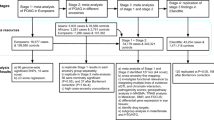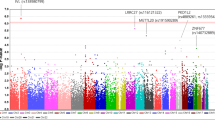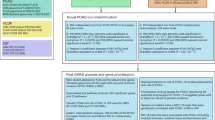Abstract
Primary angle closure glaucoma (PACG) is a major cause of blindness worldwide. We conducted a genome-wide association study including 1,854 PACG cases and 9,608 controls across 5 sample collections in Asia. Replication experiments were conducted in 1,917 PACG cases and 8,943 controls collected from a further 6 sample collections. We report significant associations at three new loci: rs11024102 in PLEKHA7 (per-allele odds ratio (OR) = 1.22; P = 5.33 × 10−12), rs3753841 in COL11A1 (per-allele OR = 1.20; P = 9.22 × 10−10) and rs1015213 located between PCMTD1 and ST18 on chromosome 8q (per-allele OR = 1.50; P = 3.29 × 10−9). Our findings, accumulated across these independent worldwide collections, suggest possible mechanisms explaining the pathogenesis of PACG.
This is a preview of subscription content, access via your institution
Access options
Subscribe to this journal
Receive 12 print issues and online access
$209.00 per year
only $17.42 per issue
Buy this article
- Purchase on Springer Link
- Instant access to full article PDF
Prices may be subject to local taxes which are calculated during checkout


Similar content being viewed by others
References
Thylefors, B., Negrel, A.D., Pararajasegaram, R. & Dadzie, K.Y. Global data on blindness. Bull. World Health Organ. 73, 115–121 (1995).
Quigley, H.A. & Broman, A.T. The number of people with glaucoma worldwide in 2010 and 2020. Br. J. Ophthalmol. 90, 262–267 (2006).
Foster, P.J. & Johnson, G.J. Glaucoma in China: how big is the problem? Br. J. Ophthalmol. 85, 1277–1282 (2001).
Hornby, S.J., Adolph, S., Gilbert, C.E., Dandona, L. & Foster, A. Visual acuity in children with coloboma: clinical features and a new phenotypic classification system. Ophthalmology 107, 511–520 (2000).
Dandona, L. et al. Angle-closure glaucoma in an urban population in southern India. The Andhra Pradesh eye disease study. Ophthalmology 107, 1710–1716 (2000).
Quigley, H.A., Congdon, N.G. & Friedman, D.S. Glaucoma in China (and worldwide): changes in established thinking will decrease preventable blindness. Br. J. Ophthalmol. 85, 1271–1272 (2001).
Lowe, R.F. Primary angle-closure glaucoma. Inheritance and environment. Br. J. Ophthalmol. 56, 13–20 (1972).
Amerasinghe, N. et al. The heritability and sibling risk of angle closure in Asians. Ophthalmology 118, 480–485 (2011).
Congdon, N., Wang, F. & Tielsch, J.M. Issues in the epidemiology and population-based screening of primary angle-closure glaucoma. Surv. Ophthalmol. 36, 411–423 (1992).
Wong, T.Y., Loon, S.C. & Saw, S.M. The epidemiology of age related eye diseases in Asia. Br. J. Ophthalmol. 90, 506–511 (2006).
Awadalla, M.S., Thapa, S.S., Burdon, K.P., Hewitt, A.W. & Craig, J.E. The association of hepatocyte growth factor (HGF) gene with primary angle closure glaucoma in the Nepalese population. Mol. Vis. 17, 2248–2254 (2011).
Awadalla, M.S., Burdon, K.P., Kuot, A., Hewitt, A.W. & Craig, J.E. Matrix metalloproteinase-9 genetic variation and primary angle closure glaucoma in a Caucasian population. Mol. Vis. 17, 1420–1424 (2011).
Michael, S., Qamar, R., Akhtar, F., Khan, W.A. & Ahmed, A. C677T polymorphism in the methylenetetrahydrofolate reductase gene is associated with primary closed angle glaucoma. Mol. Vis. 14, 661–665 (2008).
Ghoussaini, M. et al. Genome-wide association analysis identifies three new breast cancer susceptibility loci. Nat. Genet. 44, 312–318 (2012).
Thomas, G. et al. A multistage genome-wide association study in breast cancer identifies two new risk alleles at 1p11.2 and 14q24.1 (RAD51L1). Nat. Genet. 41, 579–584 (2009).
Kote-Jarai, Z. et al. Seven prostate cancer susceptibility loci identified by a multi-stage genome-wide association study. Nat. Genet. 43, 785–791 (2011).
Bellenguez, C. et al. Genome-wide association study identifies a variant in HDAC9 associated with large vessel ischemic stroke. Nat. Genet. 44, 328–333 (2012).
Kooner, J.S. et al. Genome-wide association study in individuals of South Asian ancestry identifies six new type 2 diabetes susceptibility loci. Nat. Genet. 43, 984–989 (2011).
Australia and New Zealand Multiple Sclerosis Genetics Consortium (ANZgene). Genome-wide association study identifies new multiple sclerosis susceptibility loci on chromosomes 12 and 20. Nat. Genet. 41, 824–828 (2009).
Reveille, J.D. et al. Genome-wide association study of ankylosing spondylitis identifies non-MHC susceptibility loci. Nat. Genet. 42, 123–127 (2010).
Khor, C.C. et al. Genome-wide association study identifies FCGR2A as a susceptibility locus for Kawasaki disease. Nat. Genet. 43, 1241–1246 (2011).
Höglinger, G.U. et al. Identification of common variants influencing risk of the tauopathy progressive supranuclear palsy. Nat. Genet. 43, 699–705 (2011).
Sawcer, S. et al. Genetic risk and a primary role for cell-mediated immune mechanisms in multiple sclerosis. Nature 476, 214–219 (2011).
Nalls, M.A. et al. Imputation of sequence variants for identification of genetic risks for Parkinson's disease: a meta-analysis of genome-wide association studies. Lancet 377, 641–649 (2011).
Burdon, K.P. et al. Genome-wide association study identifies susceptibility loci for open angle glaucoma at TMCO1 and CDKN2B-AS1. Nat. Genet. 43, 574–578 (2011).
Thorleifsson, G. et al. Common variants near CAV1 and CAV2 are associated with primary open-angle glaucoma. Nat. Genet. 42, 906–909 (2010).
Wiggs, J.L. et al. Common variants near CAV1 and CAV2 are associated with primary open-angle glaucoma in Caucasians from the USA. Hum. Mol. Genet. 20, 4707–4713 (2011).
Pulimeno, P., Bauer, C., Stutz, J. & Citi, S. PLEKHA7 is an adherens junction protein with a tissue distribution and subcellular localization distinct from ZO-1 and E-cadherin. PLoS ONE 5, e12207 (2010).
Meng, W., Mushika, Y., Ichii, T. & Takeichi, M. Anchorage of microtubule minus ends to adherens junctions regulates epithelial cell-cell contacts. Cell 135, 948–959 (2008).
Harris, T.J. & Tepass, U. Adherens junctions: from molecules to morphogenesis. Nat. Rev. Mol. Cell Biol. 11, 502–514 (2010).
Tian, B., Geiger, B., Epstein, D.L. & Kaufman, P.L. Cytoskeletal involvement in the regulation of aqueous humor outflow. Invest. Ophthalmol. Vis. Sci. 41, 619–623 (2000).
Quigley, H.A. et al. Iris cross-sectional area decreases with pupil dilation and its dynamic behavior is a risk factor in angle closure. J. Glaucoma 18, 173–179 (2009).
Quigley, H.A., Friedman, D.S. & Congdon, N.G. Possible mechanisms of primary angle-closure and malignant glaucoma. J. Glaucoma 12, 167–180 (2003).
Aptel, F. & Denis, P. Optical coherence tomography quantitative analysis of iris volume changes after pharmacologic mydriasis. Ophthalmology 117, 3–10 (2010).
Levy, D. et al. Genome-wide association study of blood pressure and hypertension. Nat. Genet. 41, 677–687 (2009).
Davila, S. et al. Genome-wide association study identifies variants in the CFH region associated with host susceptibility to meningococcal disease. Nat. Genet. 42, 772–776 (2010).
Gharavi, A.G. et al. Genome-wide association study identifies susceptibility loci for IgA nephropathy. Nat. Genet. 43, 321–327 (2011).
Klein, R.J. et al. Complement factor H polymorphism in age-related macular degeneration. Science 308, 385–389 (2005).
Richards, A.J. et al. A family with Stickler syndrome type 2 has a mutation in the COL11A1 gene resulting in the substitution of glycine 97 by valine in α1(XI) collagen. Hum. Mol. Genet. 5, 1339–1343 (1996).
Snead, M.P. & Yates, J.R. Clinical and molecular genetics of Stickler syndrome. J. Med. Genet. 36, 353–359 (1999).
George, R. et al. Ocular biometry in occludable angles and angle closure glaucoma: a population based survey. Br. J. Ophthalmol. 87, 399–402 (2003).
Michael, I., Shmoish, M., Walton, D.S. & Levenberg, S. Interactions between trabecular meshwork cells and lens epithelial cells: a possible mechanism in infantile aphakic glaucoma. Invest. Ophthalmol. Vis. Sci. 49, 3981–3987 (2008).
Jandrig, B. et al. ST18 is a breast cancer tumor suppressor gene at human chromosome 8q11.2. Oncogene 23, 9295–9302 (2004).
Yang, J., Siqueira, M.F., Behl, Y., Alikhani, M. & Graves, D.T. The transcription factor ST18 regulates proapoptotic and proinflammatory gene expression in fibroblasts. FASEB J. 22, 3956–3967 (2008).
Mathieson, I. & McVean, G. Differential confounding of rare and common variants in spatially structured populations. Nat. Genet. 44, 243–246 (2012).
Diehn, J.J., Diehn, M., Marmor, M.F. & Brown, P.O. Differential gene expression in anatomical compartments of the human eye. Genome Biol. 6, R74 (2005).
Jun, A.S. et al. Microarray analysis of gene expression in human donor corneas. Arch. Ophthalmol. 119, 1629–1634 (2001).
Pomerantz, M.M. et al. The 8q24 cancer risk variant rs6983267 shows long-range interaction with MYC in colorectal cancer. Nat. Genet. 41, 882–884 (2009).
Tuupanen, S. et al. The common colorectal cancer predisposition SNP rs6983267 at chromosome 8q24 confers potential to enhanced Wnt signaling. Nat. Genet. 41, 885–890 (2009).
Othman, M.I. et al. Autosomal dominant nanophthalmos (NNO1) with high hyperopia and angle-closure glaucoma maps to chromosome 11. Am. J. Hum. Genet. 63, 1411–1418 (1998).
Sundin, O.H. et al. Extreme hyperopia is the result of null mutations in MFRP, which encodes a Frizzled-related protein. Proc. Natl. Acad. Sci. USA 102, 9553–9558 (2005).
Li, H. et al. Localization of a novel gene for congenital nonsyndromic simple microphthalmia to chromosome 2q11–14. Hum. Genet. 122, 589–593 (2008).
Purcell, S. et al. PLINK: a tool set for whole-genome association and population-based linkage analyses. Am. J. Hum. Genet. 81, 559–575 (2007).
1000 Genomes Project Consortium. A map of human genome variation from population-scale sequencing. Nature 467, 1061–1073 (2010).
Teo, Y.Y. et al. Singapore Genome Variation Project: a haplotype map of three Southeast Asian populations. Genome Res. 19, 2154–2162 (2009).
Purcell, S., Cherny, S.S. & Sham, P.C. Genetic Power Calculator: design of linkage and association genetic mapping studies of complex traits. Bioinformatics 19, 149–150 (2003).
Acknowledgements
The authors thank all individuals with PACG and controls who have participated in this genetic study. We thank the following for contribution of cases and controls: J. Chua, D. Goh, R. Husain, N. Amerasinghe and A. Narayanaswamy of the Singapore National Eye Centre/Singapore Eye Research Institute; L.H. Thean, C. Aquino, C. Sng and A. Tan of the National University Hospital, Singapore; B.-A. Lim and L. Yip of Tan Tock Seng Hospital, Singapore; and Y. Liang, S. Li, X. Duan, F. Wang, X. Yang, Q. Zhou and X. Yang of the Handan Eye Study, China. The authors would also like to thank C. Chakarova, P. Ostergaard, S. Jeffery, H.J. Cordell, P.T. Khaw, D.F. Garway-Heath, A.C. Viswanathan, W.-Y. Meah, S. Chen, D. Venkataraman, L.-W. Koh, X.Y. Ng, H.-B. Toh, K.-K. Heng and X.Y. Chen for administrative, technical and genotyping support. This work was supported by grants from the National Medical Research Council, Singapore (NMRC/TCR/002-SERI/2008 (R626/47/2008TCR), CSA R613/34/2008, NMRC 0796/2003 and STaR/0003/2008), the National Research Foundation of Singapore, the Biomedical Research Council, Singapore (BMRC 09/1/35/19/616 and 08/1/35/19/550), Genome Institute of Singapore Intramural funding, the Beijing Municipal Natural Science Foundation (7102036), the Key Project of the Beijing Municipal Natural Science Foundation (7081001) and the Key Project of the National Natural Science Foundation of China (81030016).
Author information
Authors and Affiliations
Contributions
T.A., N. Wang, E.N.V. and C.-C.K. are the overall principal investigators who were jointly responsible for conception of the project, funding, study design and planning of the analysis strategy. C.Q., M.E.N., R.G., L.-J.C., T.D., K.A.-A., C.K.H., S.L., M.Z. and L.-S.A.T. are the lead coordinators for sample collection. S.A.P., L.X., H.J., C.-L.H., C.C.Y.T., R.-Y.W., P.T.K.C., D.H.S., F.T.O., N.S., E.A.O., H.-T.W., G.T., S.F., H.M., D.T.L.H., H.W., B.F., M.B., B.S., A.C.H., K.Y.L., Y.L., Y.-X.W., D.N.H., T.T.W., S.-C.L., V.K.Y.Y., A.Y., D.S.C.L. and S.A.A.-O. were the clinicians responsible for obtaining informed consent and enrolling study participants. K.S.S., W.-T.T. and X.S. performed statistical analysis. V.H.K.Y. performed gene expression analysis. C.Q., H.J., N. Wang, R.G., S.S., L.V., L.-J.C., C.K.H., M.Z. and C.-P.P. contributed to the genotyping and analysis of cases and controls for the Beijing, Chennai and Shantou samples. T.N.B.C. and C.P.S. contributed to the genotyping and analysis of the Vietnamese control group. J.-X.B. and Y.-X.Z. contributed to the genotyping and analysis of the Guangdong control group. P.J.F., L.V., T.-Y.W., C.-P.P., D.N.H., S.A.A.-O. and L.-S.A.T. are site principal investigators for their respective sample collections. S.S., C.-Y.C., V.L.R., G.K., S.K.I., T.A.S., S.M.L.T., R.L., B.K.C., Y.-F.Z., N. Waseem, K.-S.C., R.R.A., M.A.H., M.L.H., S.S.B., Y.Y.T., D.T.T., J.B.J., E.-S.T., S.-M.S. and J.L. provided intellectual input and/or contributed laboratory reagents or analysis for the project. All authors were responsible for critical revision of the manuscript. The manuscript was written by C.-C.K., E.N.V., M.E.N. and T.A.
Corresponding authors
Ethics declarations
Competing interests
The authors declare no competing financial interests.
Supplementary information
Supplementary Text and Figures
Supplementary Note, Supplementary Tables 1–9 and Supplementary Figures 1–5 (PDF 2566 kb)
Rights and permissions
About this article
Cite this article
Vithana, E., Khor, CC., Qiao, C. et al. Genome-wide association analyses identify three new susceptibility loci for primary angle closure glaucoma. Nat Genet 44, 1142–1146 (2012). https://doi.org/10.1038/ng.2390
Received:
Accepted:
Published:
Issue Date:
DOI: https://doi.org/10.1038/ng.2390
This article is cited by
-
Impact of rs11024102 PLEKHA7, rs3753841 COL11A1 single nucleotide polymorphisms, and serum levels of oxidative stress markers on the risk of primary angle-closure glaucoma in Egyptians
Journal of Genetic Engineering and Biotechnology (2022)
-
New loci for refractive errors and ocular biometric parameters in young Chinese Han adults
Science China Life Sciences (2022)
-
Haplotype-based genomic analysis reveals novel association of CNTNAP5 genic region with primary angle closure glaucoma
Journal of Biosciences (2021)



